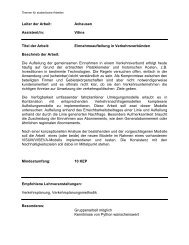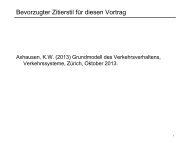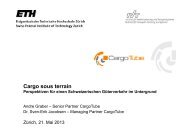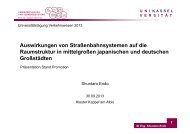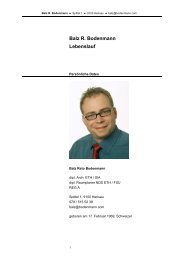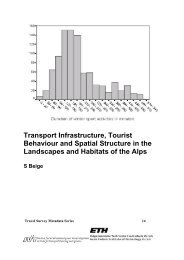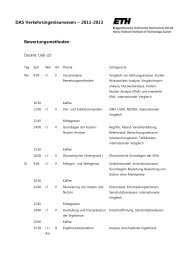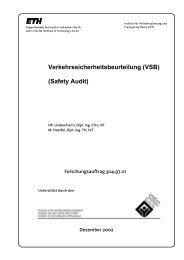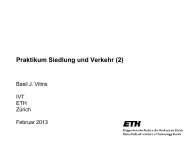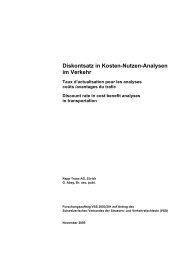A Tour-Based Model of Travel Mode Choice - Civil Engineering ...
A Tour-Based Model of Travel Mode Choice - Civil Engineering ...
A Tour-Based Model of Travel Mode Choice - Civil Engineering ...
You also want an ePaper? Increase the reach of your titles
YUMPU automatically turns print PDFs into web optimized ePapers that Google loves.
A <strong>Tour</strong>-<strong>Based</strong> <strong><strong>Mode</strong>l</strong> <strong>of</strong> <strong>Travel</strong> <strong>Mode</strong> <strong>Choice</strong><br />
Eric J. Miller, University <strong>of</strong> Toronto<br />
Matthew J. Roorda, University <strong>of</strong> Toronto<br />
Juan Antonio Carrasco, University <strong>of</strong> Toronto<br />
Conference paper<br />
Session XXX<br />
Moving through nets:<br />
The physical and social dimensions <strong>of</strong> travel<br />
10 th International Conference on <strong>Travel</strong> Behaviour Research<br />
Lucerne, 10-15. August 2003
10 th International Conference on <strong>Travel</strong> Behaviour Research<br />
August 10-15, 2003<br />
A <strong>Tour</strong>-<strong>Based</strong> <strong><strong>Mode</strong>l</strong> <strong>of</strong> <strong>Travel</strong> <strong>Mode</strong> <strong>Choice</strong><br />
Eric J. Miller, Matthew J. Roorda and Juan Antonio Carrasco<br />
Department <strong>of</strong> <strong>Civil</strong> <strong>Engineering</strong><br />
University <strong>of</strong> Toronto<br />
Toronto, Canada<br />
Phone: 01-416-978-4076<br />
Fax: 01-416-978-5054<br />
eMail: miller@civ.utoronto.ca, roordam@ecf.utoronto.ca, carrasc@ecf.utoronto.ca<br />
Abstract<br />
This paper presents a new tour-based mode choice model. The model is agent-based: both<br />
households and individuals are modelled within an object-oriented, microsimulation framework.<br />
The model is household-based in that inter-personal household constraints on vehicle<br />
usage are modelled, and the auto passenger mode is modelled as a joint decision between the<br />
driver and the passenger(s) to ride-share. Decisions are modelled using a random utility<br />
framework. Utility signals are used to communicate preferences among the agents and to make<br />
trade-<strong>of</strong>fs among competing demands. Each person is assumed to choose the “best” combination<br />
<strong>of</strong> modes available to execute each tour, subject to auto availability constraints that are determined<br />
at the household level. The household’s allocations <strong>of</strong> resources (i.e., cars to drivers<br />
and drivers to ride-sharing passengers) are based on maximizing overall household utility, subject<br />
to current household resource levels. The model is activity-based: it is designed to be integrated<br />
within a household-based activity scheduling microsimulator. The model is both chainbased<br />
and trip-based. It is trip-based in that the ultimate output <strong>of</strong> the model is a chosen, feasible<br />
travel mode for each trip in the simulation. These trip modes are, however, determined<br />
through a chain-based analysis. A key organizing principle in the model is that if a car is to be<br />
used on a tour, then it must be used for the entire chain, since the car must be returned home at<br />
the end <strong>of</strong> the tour. No such constraint, however, exists with respect to other modes such as<br />
walk and transit. The paper presents the full conceptual model and an initial empirical prototype.<br />
Keywords<br />
<strong>Mode</strong> choice, tour-based, microsimulation, household-based, International Conference on<br />
<strong>Travel</strong> Behaviour Research, IATBR<br />
Preferred citation<br />
Miller, Eric J., Matthew J. Roorda and Juan Antonio Carrasco (2003) A <strong>Tour</strong>-<strong>Based</strong> <strong><strong>Mode</strong>l</strong> <strong>of</strong><br />
<strong>Travel</strong> <strong>Mode</strong> <strong>Choice</strong>, paper presented at the 10 th International Conference on <strong>Travel</strong> Behaviour<br />
Research, Lucerne, August 2003.<br />
I
10 th International Conference on <strong>Travel</strong> Behaviour Research<br />
August 10-15, 2003<br />
1. Introduction<br />
This paper introduces a new tour-based mode choice model that takes into account withinhousehold,<br />
inter-personal interactions. Both a conceptual model and an operational prototype<br />
are presented within the paper.<br />
Section 2 discusses key design concepts underlying the model. Section 3 briefly reviews the<br />
current state <strong>of</strong> the mode choice modelling art. Section 4 describes the conceptual model.<br />
Sections 5-8 then deal with an empirical test <strong>of</strong> the conceptual model in terms <strong>of</strong>: prototype<br />
assumptions, data, estimation procedure, and model estimation results. Finally, Section 9<br />
summarises the paper and briefly discusses next steps in the model’s development.<br />
2. Design Concepts<br />
The mode choice model presented in this paper simultaneously determines the travel mode for<br />
each trip on a person’s home-based tour or trip chain, which consists <strong>of</strong> a connected set <strong>of</strong><br />
trips, the first <strong>of</strong> which departs from the trip-maker’s home and the last <strong>of</strong> which has the person’s<br />
home as its destination. Non-home-based sub-chains that begin and end at the same anchor<br />
point (work, school, etc.) are also handled.<br />
The model is specifically designed to be integrated within the <strong>Travel</strong>/Activity Scheduler for<br />
Household Agents (TASHA) activity scheduling model (Miller and Roorda, 2003). TASHA<br />
generates all out-<strong>of</strong>-home activities engaged in by all household members over an entire<br />
twenty-four hour weekday. Thus, the mode choice model must deal “simultaneously” with<br />
mode choices for trips <strong>of</strong> all purposes (in any combination within a given trip chain) over all<br />
time periods within the day, for trip chains <strong>of</strong> arbitrary complexity. Despite this need to interface<br />
with TASHA, the model could be used equally well with any activity- or trip-based<br />
travel demand model that generates home-based tours.<br />
The model is a disaggregate one, which predicts the mode choices <strong>of</strong> individual trip-makers.<br />
A key feature <strong>of</strong> the model, however, is that it explicitly recognizes that these decisions occur<br />
within the context <strong>of</strong> the individual’s household. Household interactions include:<br />
1. When conflicts exist between household members’ desire to use the household’s automobile(s),<br />
these conflicts are resolved at the household level, with “the household deciding”<br />
which person gets the car and which person must use another means <strong>of</strong> travel for this trip<br />
chain. Thus, “auto availability”, which is inevitably handled in an approximate and ad hoc<br />
manner in individual, trip-based models, is endogenously determined within this model.<br />
2. Joint activities, in which two or more household members participate (e.g., go to a movie<br />
together), usually involve the activity participants travelling together. In such cases, the joint<br />
choice <strong>of</strong> mode should be explicitly dealt with, within the context <strong>of</strong> the overall trip-chains for<br />
the participants that contain the joint activity(ies).<br />
2
10 th International Conference on <strong>Travel</strong> Behaviour Research<br />
August 10-15, 2003<br />
3. The decision <strong>of</strong> one household member to drive another household member to his/her activity<br />
location (e.g., drop a child at school or daycare) is explicitly determined within the context<br />
<strong>of</strong> the trip chains and travel mode opportunities <strong>of</strong> the persons involved.<br />
The model is designed to run within a Monte Carlo microsimulation framework, in which explicit<br />
mode choices are generated (e.g., auto-drive is used for this trip) rather than a probability<br />
distribution <strong>of</strong> possible outcomes (e.g., there is a 55% chance that auto-drive will be used<br />
for this trip). This is essential, since the model is intended to return the mode choices to an<br />
activity scheduling model, which must have an explicit travel time and mode for each trip.<br />
This need for a specific, discrete response from the model, rather than a real-valued probability<br />
is a key feature <strong>of</strong> the model. This influences the way in which the model is formulated,<br />
estimated and applied. This means that many model replications need to be computed in order<br />
to achieve a statistically valid representation <strong>of</strong> the process. At the same time, however,<br />
such a model can exploit the microsmulation framework in a number <strong>of</strong> attractive ways, including<br />
being able to handle complex error structures and permitting multiple, complex decision<br />
processes to be modelled in a detailed, internally consistent fashion, in both cases without<br />
excessive additional mathematical or computational complexity.<br />
3. Literature Review – <strong>Tour</strong>-<strong>Based</strong> <strong>Mode</strong> <strong>Choice</strong> <strong><strong>Mode</strong>l</strong>s<br />
The literature on disaggregate mode choice models is vast, with a history <strong>of</strong> more than thirty<br />
years. The majority <strong>of</strong> these models are trip-based, focus on a specific purpose (e.g., Ortúzar,<br />
1983; Asensio, 2002), rely heavily on traditional random utility maximization (RUM) theory,<br />
and incorporate trip-based assumptions <strong>of</strong> conventional “four-stage” models. The lack <strong>of</strong> behavioural<br />
realism <strong>of</strong> trip-based models, however, has been criticized by several authors (e.g.,<br />
Ben-Akiva, et al., 1998), who emphasize the importance <strong>of</strong> a more comprehensive tour-based<br />
approach.<br />
Most <strong>of</strong> the tour-based models have been developed either within the context <strong>of</strong> European national<br />
models in countries such as The Netherlands (HCG, 1992), Italy (Cascetta, et al.,<br />
1993), Sweden (Algers, et al., 1997; Beser and Algers, 2002) and Denmark (Fosgerau, 2002),<br />
or US cities such as San Francisco (Bradley, et al., 2001; Jonnalagadda, et al., 2001), Boston<br />
(Bowman and Ben-Akiva, 2000), and Portland (Bowman, et al., 1998). Although differences<br />
exist among them, these models share several important features:<br />
• reliance on some “tree logit” form;<br />
• simplification in the definition and construction <strong>of</strong> tours;<br />
• assumption <strong>of</strong> a “main” mode;<br />
• separate calibration by purpose; and<br />
• use <strong>of</strong> explicit assumptions about car availability rather than car allocation per se.<br />
3
10 th International Conference on <strong>Travel</strong> Behaviour Research<br />
August 10-15, 2003<br />
With respect to the specification <strong>of</strong> the models, a nested logit (NL) specification, incorporating<br />
different levels <strong>of</strong> choices, is common practice. An example <strong>of</strong> this is the Stockholm<br />
model, where three NL substructures are used: one for “long-term” decisions (car ownership<br />
and destination), a second for primary destinations, and a third for the secondary destinations.<br />
These three substructures are connected by inclusive values or “logsums” <strong>of</strong> utilities that carry<br />
information about the decisions made on the lower levels to upper levels, in a sequential procedure.<br />
Similarly, in the San Francisco model, mode choice is modelled as a multinomial logit<br />
(MNL) that “informs” the upper destination decision level through logsums. A final example<br />
is provided by Bowman, et al. (1998), who assume five types <strong>of</strong> models in a hierarchy <strong>of</strong> activity<br />
patterns, and primary and secondary destination-mode choices.<br />
In general, the use <strong>of</strong> logsums is a common practice to avoid the difficulties that are associated<br />
with the simultaneous estimation <strong>of</strong> complex RUM tree structures. Computational performance,<br />
however, can still be a problem. In addition, some measures <strong>of</strong> expected utility<br />
may be excluded, producing specification problems (e.g., Bowman, et al., 1998). Sequential<br />
structures also imply that the different levels <strong>of</strong> decision do not “share” all the information,<br />
and that the order in which decisions are made must be defined in an ad hoc way.<br />
The formation <strong>of</strong> the tours in these models varies from using a nested structure for frequency<br />
(e.g., Algers, et al., 1997), “constructing” the tours from trip data (e.g., HCG, 1992; Fosgerau,<br />
2002), and explicitly modelling the activity schedule (e.g., Bowman, et al., 1998). The direct<br />
“construction” <strong>of</strong> the tour from trip data implies some simplifications. The Danish model, for<br />
example, includes at most two tours per chain, defines three purposes as a maximum, and incorporates<br />
some restrictions on frequencies, depending on the purpose. In the Portland model,<br />
the primary activity <strong>of</strong> the day, and whether it occurs at home or on a tour, is first defined. If<br />
the primary activity is on-tour, the activity pattern model also determines the type <strong>of</strong> trip<br />
chain, defined by the number and sequence <strong>of</strong> stops in the tour.<br />
The use <strong>of</strong> a single mode choice for primary and secondary destinations implies the assumption<br />
<strong>of</strong> a “main” mode in the chain; i.e., it is assumed that travellers do not switch modes<br />
within the tour, and the detailed consideration <strong>of</strong> mode preferences is made only with respect<br />
to the main mode. 1 In other cases this assumption is partially relaxed. In the Portland model,<br />
for example, a set <strong>of</strong> rules is used to aggregate all the possible combinations <strong>of</strong> modes into a<br />
manageable number; while in the San Francisco model the trip mode choice is applied for<br />
each stop <strong>of</strong> the tour, conditional on the predicted “main” mode and the origin, destination,<br />
and time <strong>of</strong> day.<br />
Another feature <strong>of</strong> these tour-based models is that each tour purpose is separately calibrated.<br />
Further, the Stockholm model, for example, uses different tree structures (simplifying for<br />
some purposes), and different units <strong>of</strong> decisions (individuals for work-based tours, and a<br />
combination <strong>of</strong> household agents for shopping). In addition, a common practice is for purposes<br />
to dictate the tour formation.<br />
1 Another recent example <strong>of</strong> this approach can be found in Cirillo and Axhausen (2002)<br />
4
10 th International Conference on <strong>Travel</strong> Behaviour Research<br />
August 10-15, 2003<br />
With respect to car allocation, treatment varies among models. For example, the Danish<br />
model directly incorporates household car availability in the tree structure; the Stockholm<br />
model considers a level for the car allocation process that defines the possible mode choice<br />
options; and the San Francisco model considers vehicle availability at higher levels, above<br />
tour and trip generation. However, it is not clear whether these models allow for more complex<br />
car allocation behavior, such as the use <strong>of</strong> a same car by different members <strong>of</strong> the household<br />
within the day.<br />
Finally, another relevant group <strong>of</strong> complex mode-choice models are the so-called rule-based<br />
models, which try to incorporate modal choices within the scheduling process itself. Some<br />
examples are the ALBATROSS model by Arentze and Timmermans (2000), and the work by<br />
Kitamura, et al., (2000). In the case <strong>of</strong> ALBATROSS, mode choice is incorporated in two locations<br />
within the six-step scheduling process: in the first step, which defines the mode for<br />
primary work activities; and in the fifth step, at the level <strong>of</strong> each trip chain with “other” nonprimary-work<br />
purposes. Kitamura, et al. (2000), on the other hand, use a process <strong>of</strong> “sequential<br />
history and time-<strong>of</strong>-day dependent structure”, where mode choice occurs after the activity<br />
type, duration, and destination choices. <strong>Mode</strong> choice is modelled in this case using transition<br />
probabilities that depend on the previous trips, using the same concept <strong>of</strong> “primary mode” as<br />
discussed before.<br />
4. Conceptual <strong><strong>Mode</strong>l</strong><br />
4.1 Introduction<br />
In this section the conceptual model <strong>of</strong> tour-based mode choice is developed. This model is<br />
elaborated in several steps. First, the “base” model dealing with how an individual chooses<br />
the travel mode(s) to be used on a single home-based trip chain in the absence <strong>of</strong> householdlevel<br />
constraints (e.g., car availability) or interactions (e.g., ride-sharing) is presented. Second,<br />
a household-level mechanism for resolving competing demands for the household’s vehicle<br />
fleet is developed. Finally, procedures for dealing with ride-sharing among household<br />
members, either as part <strong>of</strong> a “serve-passenger” task or as part <strong>of</strong> a joint travel activity, are<br />
sketched.<br />
4.2 Individual Trip-Maker <strong>Tour</strong> <strong>Mode</strong> <strong>Choice</strong><br />
The problem at hand is to determine the travel modes used for each trip in a known set <strong>of</strong><br />
home-based tours for each individual within a household for a twenty-four-hour weekday.<br />
For the moment it is assumed that if a licensed driver wishes to use a household car on a<br />
given trip chain he/she may do so. It is also initially assumed that “auto passenger” or “ridesharing”<br />
modes <strong>of</strong> travel are not available.<br />
Sub-chains, involving a connected set <strong>of</strong> trips that begin and end at the same non-home anchor<br />
point, may exist within the model. Although virtually any activity location might be an<br />
5
10 th International Conference on <strong>Travel</strong> Behaviour Research<br />
August 10-15, 2003<br />
anchor point, in the prototype presented here, a worker’s “usual place <strong>of</strong> work” is the only anchor<br />
point considered. The anchor point is a critical concept within the model, since it is only<br />
at an anchor point that a trip-maker can decide to drive a vehicle on the trip chain (or subchain),<br />
and if the vehicle is taken, it must be used on all trips within the chain (or sub-chain),<br />
at least until the next anchor point is reached. Thus, one can label the auto-drive mode as<br />
chain-based in that the decision to use this mode is inherently a chain-level one in that it<br />
commits one to use the mode for the entire chain or sub-chain.<br />
No similar commitment exists in the case <strong>of</strong> other modes <strong>of</strong> travel, such as transit, walk and<br />
taxi. One may walk to work in the morning and take transit home at night if one feels tired or<br />
if the weather is bad. Thus, one can label such modes as trip-based modes since the decision<br />
to use one <strong>of</strong> these modes on a given trip depends fundamentally on the individual trip and<br />
does not necessarily impact the choice <strong>of</strong> mode for other trips within the chain.<br />
Figure 1 integrates these concepts into an overall decision-tree for a trip-maker’s choice <strong>of</strong><br />
travel mode(s) for a single tour. Note that at the overall home-based tour level two options<br />
exist: drive chain (D), or non-personal-vehicle chain (NPV). Also note that within the NPV<br />
chain, trip modes are selected on an individual trip basis.<br />
Figure 1<br />
<strong>Tour</strong>-Level Decision Tree With a Sub-Chain<br />
Drive Option for Chain c<br />
Chain c:<br />
1. Home-Work<br />
2. Work-Lunch<br />
3. Lunch-Meeting<br />
4. Meeting-Work<br />
5. Work-Home<br />
NPV Option for Chain c<br />
Drive for<br />
Sub-chain s<br />
m1 = drive<br />
Sub-Chain s:<br />
2. Work-Lunch<br />
3. Lunch-Meeting<br />
4. Meeting-Work<br />
NPV for<br />
Sub-chain s<br />
m1 m2 m3<br />
m4 m5<br />
mN = mode chosen for trip N<br />
m2 = drive<br />
m3 = drive<br />
m4 = drive<br />
m5 = drive<br />
m2<br />
m3 m4<br />
6
10 th International Conference on <strong>Travel</strong> Behaviour Research<br />
August 10-15, 2003<br />
A random utility approach is adopted in this model to determine the choice among these options.<br />
The utility <strong>of</strong> person p choosing mode m for trip t on trip chain c, U(m,t,p), is:<br />
U(m,t,p) = V(m,t,p) + ε(m,t,p) t∈T(c,p); m∈f(t,p) [1]<br />
where:<br />
V(m,t,p)=<br />
ε(m,t,p)=<br />
T(c,p) =<br />
f(t,p) =<br />
systematic utility component <strong>of</strong> mode m for trip t for person p<br />
random utility component <strong>of</strong> mode m for trip t for person p<br />
set <strong>of</strong> trips on chain c for person p<br />
set <strong>of</strong> feasible modes for trip t for person p<br />
Further, we assume that the utility for a specific combination <strong>of</strong> chosen modes for the entire<br />
trip chain c, U(M,p) is simply the sum <strong>of</strong> the individual trip utilities:<br />
U(M,p) = ∑ t∈T(c,p) V(m(t),t,p) + ∑ t∈T(c,p) ε(m(t),t,p) M∈F(c,p) [2]<br />
where:<br />
M = one set <strong>of</strong> specific feasible modes for the trips on chain c for person p (the<br />
chain mode set)<br />
F(c,p) = set <strong>of</strong> chain mode sets for chain c for person p; this set is defined by both a<br />
priori trip constraints (e.g., trip distance too long to walk) and chain-based “contextual”<br />
constraints (e.g., can’t use auto-drive on return trip if it was not used on the outbound<br />
trip)<br />
A special case <strong>of</strong> M is the all-drive chain (D), for which equation [2] simplifies to:<br />
U(D,p) = ∑ t∈T(c,p) V(d,t,p) + ∑ t∈T(c,p) ε(d,t,p) [3]<br />
where d represents the drive trip mode.<br />
The other values <strong>of</strong> M involve the feasible combinations <strong>of</strong> individual trip-based mode<br />
choices (e.g., for a three-trip tour: transit-transit-transit; transit-walk-taxi; etc.) that define the<br />
NPV chain option. Since in the case <strong>of</strong> the NPV option the mode for each trip in the chain is<br />
chosen individually, equation [2] reduces to:<br />
U(NPV,p) = ∑ t∈T(c,p) MAX m∈f(t,p) [U(m,t,p)] [4]<br />
where U(NPV,p) is the optimal NPV chain mode set.<br />
Equation [2] represents a major assumption in the model design. It is essential to provide a<br />
consistent comparison between chain-based and trip-based modes, as well as to deal with<br />
7
10 th International Conference on <strong>Travel</strong> Behaviour Research<br />
August 10-15, 2003<br />
ride-sharing and joint-travel mode choices. Note that this is effectively the standard assumption<br />
implicit in trip-based models.<br />
The standard random utility assumption is made that the chain mode set chosen is M* for<br />
which:<br />
U(M*,p) ≥ U(M,p) ∀ M,M* ∈ F(c,p); M* ≠ M [5]<br />
That is, the D or (optimal) NPV chain mode set will be chosen for the given trip chain, depending<br />
on which provides the maximum utility to the trip-maker.<br />
As with any random utility model, the selection <strong>of</strong> the probability distribution for the error<br />
terms, ε(m,t,p), represents a critical step in the model specification. In most discrete choice<br />
models, criterion [5] would be integrated over the selected error distribution to yield the probability<br />
that person p would choose chain mode set M*; that is to compute:<br />
P(M*,p) = Prob[U(M*,p) ≥ U(M,p) ∀ M,M* ∈ F(c,p); M* ≠ M] [6]<br />
The error distribution is usually selected to facilitate the calculation <strong>of</strong> equation [6], which<br />
typically means the assumption <strong>of</strong> some form <strong>of</strong> either a generalized extreme value (GEV)<br />
distribution or a mixed logit representation, where the selection among these competing functional<br />
forms is driven by considerations <strong>of</strong> an appropriate covariance structure for the ε’s.<br />
Unfortunately, the model presented in equations [1]-[5] does not “fit” well within these standard<br />
functional forms. In particular, the non-personal-vehicle decision structure is nonstandard<br />
in that the overall chain mode set choice depends upon the sum <strong>of</strong> a set <strong>of</strong> individual<br />
trip mode choices. This does not translate directly into a GEV framework.<br />
In our model, we choose to forego the need for equation [6] altogether and, instead, work directly<br />
at the level <strong>of</strong> equation [5]. That is, given an assumed probability distribution for the<br />
ε’s, we generate a set <strong>of</strong> ε(m,t,p) for each mode and trip for each person p and evaluate criterion<br />
[5] directly. The chain mode set M* that receives the highest utility score is then simply<br />
selected. If P(M*,p) is required (e.g., for parameter estimation purposes), then this process is<br />
simply replicated with many independent random draws in order to simulate P(M*,p) by the<br />
frequency with which M* is selected.<br />
While recognizing that a certain computational burden is inherent in this approach (along with<br />
some estimation issues, see Section 7), it also brings with it several potentially interesting and<br />
important advantages. These include:<br />
• The modeller is free to use any probability distribution for the error terms that makes<br />
theoretical sense and is empirically supported by the data, rather than having to assume<br />
a distribution that is analytically tractable.<br />
• The approach exploits the Monte Carlo simulation framework to work directly at the<br />
behaviourally more fundamental level <strong>of</strong> the random utility, rather than having do go<br />
through the intermediate process <strong>of</strong> synthesizing choice probabilities<br />
8
10 th International Conference on <strong>Travel</strong> Behaviour Research<br />
August 10-15, 2003<br />
• Working directly at the level <strong>of</strong> the random utilities allows for very complex choice<br />
structures to be constructed in a computationally efficient, theoretically plausible way,<br />
without the need to construct increasingly unwieldy “nesting” structures.<br />
In this model, we choose to assume that the errors are normally distributed. The two obvious<br />
advantages <strong>of</strong> this assumption are:<br />
• when trip errors are added together in equation [2] to compute chain-level utilities, this<br />
utility remains normally distributed; and<br />
• very general covariance structures for the joint error distribution are supported by the<br />
multivariate normal distribution.<br />
4.3 Vehicle Allocation<br />
To this point it has been assumed that any valid driver can choose the drive mode chain option<br />
if he/she so wishes. It is possible, however, for conflicts to occur in which two or more<br />
potential drivers within a household wish to use the same vehicle at the same time. Figure 2<br />
illustrates this situation for the simple but relatively common case <strong>of</strong> a two-driver, one-vehicle<br />
household. In such cases, a conflict resolution mechanism is required to determine which<br />
driver(s) actually get to use the household’s vehicle(s).<br />
Figure 2<br />
Vehicle Allocation: 2-Driver, 1-Vehicle Case<br />
Person 1 Person 2 Car 1<br />
Time<br />
Request for<br />
car<br />
Allocation <strong>of</strong><br />
the car to a<br />
given person<br />
9
10 th International Conference on <strong>Travel</strong> Behaviour Research<br />
August 10-15, 2003<br />
Let ndr(τ) be the number <strong>of</strong> household trip-makers who wish to use a household vehicle at<br />
time τ. Let nveh be the number <strong>of</strong> vehicles available for the household’s use. If the condition<br />
holds that:<br />
ncar ≥ ndr(τ) [7]<br />
then all drivers are free to use a car on their tour. If, however, condition [7] is not true, then<br />
(ndr(τ)-ncar) trip-makers must use their “second best” chain mode option.<br />
In this model the assumption is that this decision is made so as to maximize total household<br />
utility, which is defined as the sum <strong>of</strong> the utilities <strong>of</strong> the individual household trip-makers.<br />
This is equivalent to maximizing:<br />
Σ p [U(D,p) – U(NPV,p)]x p [8]<br />
subject to: Σ p x p = ncars [9]<br />
where:<br />
x p = 1 if person p is allocated a car; = 0 otherwise.<br />
Cases may well occur in which a “second best”, non-drive option does not exist for a given<br />
trip-maker. In such cases, U(NPV,p) is currently simply set to a very large negative number<br />
so that expression [8] can still be evaluated. 2 If such a person’s request for a car is rejected,<br />
then two further options exist:<br />
1. The person may attempt to reschedule the activities on the rejected tour for another<br />
time period when a car will be available. This process lies outside <strong>of</strong> the mode choice<br />
model being discussed here.<br />
2. The household can investigate options for ride-sharing between the “accepted” and<br />
“rejected” drivers (see below).<br />
4.4 Serve-Passenger/Auto-Passenger <strong>Mode</strong>s<br />
Auto-passenger trips occur in three ways:<br />
1. shared-ride in a joint activity;<br />
2. passenger in an inter-household "car-pool"; and<br />
3. passenger being “chauffeured” in a car driven by another household member.<br />
2<br />
This suffices for present model estimation purposes, but it is not the ideal solution. It would be better to<br />
measure the actual “utility loss” associated with foregoing the trip chain. This is beyond the current capability<br />
<strong>of</strong> the prototype model, but is an area for future research.<br />
10
10 th International Conference on <strong>Travel</strong> Behaviour Research<br />
August 10-15, 2003<br />
Since each <strong>of</strong> these activities is complex and involves the interaction with at least one other<br />
person, it is argued that the auto-passenger mode should be determined as an inter-personal<br />
decision process and should not be included in the individual person tour mode choice model<br />
that has been presented above. Joint activity mode choice is discussed below. Interhousehold<br />
car-pooling is an extremely difficult process to represent, and is not addressed<br />
within the current model.<br />
Serve-passenger trips are determined in a “second-pass” procedure. That is, when a new activity<br />
episode is being inserted into a schedule (and, hence, a trip chain), auto-passenger is not<br />
considered as a mode for the new travel episodes involved. Utilities are calculated based on<br />
the other feasible modes, provisional mode choices are made, and vehicle allocations are<br />
sorted out, as has been described above. Subsequently, auto-passenger options for nondrivers<br />
are assessed.<br />
The basic logic <strong>of</strong> the serve-passenger decision is that if overall household utility can be improved<br />
through the ride-share and the ride-share is feasible (given the driver’s schedule), then<br />
it is “worth” doing. For this to happen the “utility gain” <strong>of</strong> the passenger must exceed the<br />
“utility loss” <strong>of</strong> the driver. Note that even if two people are driving, opportunities for ridesharing<br />
may still exist (i.e., substituting auto-passenger for auto-drive for one <strong>of</strong> the drivers<br />
and a SOV-drive for a rideshare-drive for the other), if the utility gain for the household is<br />
sufficient.<br />
Intra-household ride-sharing has not yet been implemented within the model prototype. For<br />
present purposes, the key point to note is that it is clear that the utility-based microsimulation<br />
modelling approach proposed in this paper is extensible to dealing with inter-personal, withinhousehold<br />
ride-share trade<strong>of</strong>fs in a way that traditional probability-based models would have<br />
difficulty undertaking.<br />
4.5 Joint <strong>Travel</strong><br />
Joint activities are household-level projects involving two or more household members.<br />
<strong>Mode</strong> choice for joint activities should be handled the same as for individual trips, except:<br />
• <strong>Mode</strong> choice is now a joint decision, simultaneously determined for all joint activity<br />
participants.<br />
• Auto-drive is replaced by shared-ride. That is, the model will not attempt to determine<br />
who drives and who is a passenger.<br />
To be consistent with the individual trip model, total travel times and travel costs must be<br />
computed by adding the travel times and costs <strong>of</strong> all joint trip members. Not only is this required<br />
to maintain a consistent treatment <strong>of</strong> trip utilities throughout the model, but it facilitates<br />
dealing with “mixed” individual-joint tours.<br />
Joint tours can occur in two ways. The more common is a “pure” joint tour, in which the<br />
11
10 th International Conference on <strong>Travel</strong> Behaviour Research<br />
August 10-15, 2003<br />
members <strong>of</strong> the joint party travel together throughout the tour. “Mixed” tours, in which one<br />
or more trips made by one or more <strong>of</strong> the joint activity members are made independently,<br />
however, are also certainly feasible. In such cases, equation [2] “simply” extends to assess<br />
the combined utility <strong>of</strong> all trips <strong>of</strong> the two (or more) trip-chains that are “linked” by the joint<br />
activities. That is, while the complexity <strong>of</strong> keeping track <strong>of</strong> the modal options across the<br />
linked tours clearly increases, conceptually the procedure remains the same as for the individual<br />
tour case.<br />
5. Prototype Implementation<br />
The conceptual model described above has been estimated in a prototype formulation. As has<br />
been discussed, this prototype does not deal with the auto passenger mode (either through intra-household<br />
ride-sharing or inter-household car-pooling), nor does it include joint activity<br />
chains. Further, to keep the initial model as simple as possible, only tours including the “primary<br />
modes” <strong>of</strong> auto-drive, transit (with walk access) and walk all-way are included. Otherwise,<br />
however, it represents a full implementation <strong>of</strong> the conceptual model, including the<br />
“dynamic” vehicle allocation among competing drivers.<br />
As noted above, the assumption <strong>of</strong> normally distributed random terms allows for a very generalized<br />
covariance structure. In order to exploit this generality somewhat in the current investigation,<br />
while keeping this preliminary analysis reasonably simple, the following error<br />
structure has been assumed:<br />
ε(m,t,p) = µ(m,p) + η(m,t,p) [10]<br />
where:<br />
µ(m,p) ≈ MVN(0,Σ) ∀ p [11]<br />
η(m,t,p) ≈ N(0,σ) ∀ m,t,p [12]<br />
That is, µ is a mode-specific error term that captures person p’s idiosyncratic taste variation<br />
for mode m, relative to the population average preference. In the simplest model tested, µ is<br />
assumed to be iid (i.e., once scaled for identification purposes, Σ is simply the identity matrix),<br />
but a heteroscedastic (non-equal diagonal terms) model is also estimated.<br />
On the other hand, η is a “pure random” effect that varies from mode to mode within a trip<br />
and from trip to trip.<br />
While in principle the two error terms could be added together (since they are both normally<br />
distributed), it is essential to keep them separate so as to be able to identify the “fixed” modespecific<br />
component relative to the “variable” trip-specific component. This model is analogous<br />
to a mixed logit model in which normally distributed alternative-specific bias parameters<br />
are imbedded within a logit kernel. Statistical identification criteria for the model are discussed<br />
in Appendix A.<br />
12
10 th International Conference on <strong>Travel</strong> Behaviour Research<br />
August 10-15, 2003<br />
Finally, while not required by either the conceptual model’s assumptions our for computational<br />
convenience, the operational prototype makes the standard assumption that the systematic<br />
utility function is linear in the parameters.<br />
6. Data<br />
The data used to estimate the prototype model parameter values are taken from the 1996<br />
Transportation Tomorrow Survey (TTS). TTS is a one-day, telephone-based, travel survey <strong>of</strong><br />
5% <strong>of</strong> households within the Greater Toronto Area (GTA) that was undertaken in the autumn<br />
<strong>of</strong> 1996 (DMG, 1997). In the survey, all trips made by all surveyed household members 11<br />
years <strong>of</strong> age or older were recorded for a randomly selected weekday, along with household<br />
socio-economic information. This trip-based dataset was converted into a set <strong>of</strong> out-<strong>of</strong>-home<br />
activities and trip-chains by Eberhard (2002).<br />
Table 1<br />
1996 TTS Total Sample & Estimation Sub-Sample Summary Statistics<br />
TTS<br />
Estimation Sample<br />
TTS Total<br />
Households<br />
(Raw)<br />
TTS Trip<br />
making<br />
households<br />
(cleaned)<br />
No carpool /<br />
rideshare / joint<br />
activities<br />
Total<br />
Final Estimation<br />
Set 1<br />
Households 88898 68538 41981 4000 3511<br />
Persons 243286 192960 106276 10177 5684<br />
2<br />
Trip Chains N/A 176041 80627 7712 6490<br />
Trips 500313 405809 180731 17238 14570<br />
Drive 3 311502 62.3% 251530 62.0% 122848 68.0% 11479 66.6% 10233 70.2%<br />
Drive Acc Subway 863 0.2% 648 0.2% 395 0.2% 29 0.2% 0 0.0%<br />
Drive Egr Subway 798 0.2% 609 0.2% 376 0.2% 28 0.2% 0 0.0%<br />
Drive Acc Go Rail 1241 0.2% 910 0.2% 649 0.4% 74 0.4% 0 0.0%<br />
Drive Egr Go Rail 1161 0.2% 862 0.2% 630 0.3% 72 0.4% 0 0.0%<br />
Non-drive Go Rail 4 2216 0.4% 1609 0.4% 878 0.5% 64 0.4% 0 0.0%<br />
Transit All-way 59760 11.9% 50793 12.5% 33932 18.8% 3442 20.0% 3135 21.5%<br />
Walk 29250 5.8% 24813 6.1% 14413 8.0% 1414 8.2% 1202 8.2%<br />
Taxi 2386 0.5% 1866 0.5% 1058 0.6% 107 0.6% 0 0.0%<br />
Schoolbus 7684 1.5% 6322 1.6% 3112 1.7% 305 1.8% 0 0.0%<br />
Bicycle 3891 0.8% 3349 0.8% 2440 1.4% 224 1.3% 0 0.0%<br />
Passenger 78768 15.7% 62311 15.4% 0 0.0% 0 0.0% 0 0.0%<br />
Other/Unknown 793 0.2% 187 0.0% 0 0.0% 0 0.0% 0 0.0%<br />
Notes:<br />
(1) Trips by modelled modes complying with all choice set rules.<br />
(2) Only includes persons making a trip. Other columns include all persons in the households.<br />
(3) Drive includes motorcycle trips.<br />
(4) “GO Rail” is the GTA commuter rail system. “Non-drive GO” indicates transit, walk,<br />
auto passenger and taxi commuter rail station access modes.<br />
13
10 th International Conference on <strong>Travel</strong> Behaviour Research<br />
August 10-15, 2003<br />
Table 1 provides summary statistics on the full TTS dataset, the total set <strong>of</strong> households for<br />
which “cleaned” sets <strong>of</strong> activities and tours were successfully constructed by Eberhard, and<br />
the subset <strong>of</strong> households which did not engage in car-pool, ride-share or joint activities (the<br />
target population for the prototype model). In order to keep model estimation computations<br />
within reasonable limits, a 4,000 household random sample was drawn from the 41,981 total<br />
households in this last category. This random sample reflects the larger group’s trip mode<br />
distribution very well. Also note that the auto-drive, transit all-way and walk modes account<br />
for 94.8% <strong>of</strong> the estimation sample trips. The commuter rail and subway drive access modes<br />
were excluded from the prototype model due to the very small number <strong>of</strong> trips made by these<br />
modes, while taxi, school-bus and bicycle trips were eliminated due to unavailability <strong>of</strong> suitable<br />
explanatory variables with which to construct modal utility functions. The end result is a<br />
final estimation dataset consisting <strong>of</strong> 3,511 households, 5,684 persons who executed at least<br />
one trip chain, 6,490 trip chains and 14,570 individual trips.<br />
All auto and transit travel times and costs were obtained from EMME/2-based network calculations<br />
performed within the GTA<strong><strong>Mode</strong>l</strong> regional travel demand modelling system for the<br />
GTA. 3 Walk travel times were estimated based on simple straight-line origin to destination<br />
travel distances and assumed average travel speeds.<br />
7. Parameter Estimation Procedure<br />
<strong><strong>Mode</strong>l</strong> parameter values were estimated by maximizing the log-likelihood function:<br />
L(β) = Σ h Σ p∈H(h) Σ c0C(p) Σ t0T(c,p) log(P(m*,t,p|β)) [13]<br />
where:<br />
H(h) = set <strong>of</strong> persons 11 years or older in household h<br />
C(p) = set <strong>of</strong> home-based tours for person p<br />
β = vector <strong>of</strong> model parameters (including parameters <strong>of</strong> the error distribution) to<br />
be estimated<br />
P(m*,t,p|β) = simulated probability <strong>of</strong> person p choosing the observed mode m* for trip t on<br />
chain c, given the model parameters β.<br />
P is simulated through a Monte Carlo process in which N sets <strong>of</strong> random utilities U are drawn<br />
for each trip for each person for each chain for a given β, equation [5] is evaluated for each<br />
draw, and the frequency with which m* is predicted to be chosen is accumulated. In order to<br />
3<br />
For EMME/2 documentation see Inro (1999). For GTA<strong><strong>Mode</strong>l</strong> documentation see Miller (2001).<br />
14
10 th International Conference on <strong>Travel</strong> Behaviour Research<br />
August 10-15, 2003<br />
account for the possibility that m* is never chosen within the N draws, P is defined as (Ortuzar<br />
and Willumsen, 2001):<br />
P(m*,t,p|β) = [F(m*,t,p|β) + 1] / [N + n t ] [14]<br />
where F(m*,t,p|β) is the number <strong>of</strong> times m* was selected for trip t out <strong>of</strong> the N draws, and n t<br />
is the number <strong>of</strong> feasible modes for trip t.<br />
Since log(P) is not analytically defined, standard gradient-based methods for optimizing [13]<br />
are not directly applicable (cf. Train, 2002). In this application a very simplistic random<br />
search procedure was used in which a large number <strong>of</strong> random parameter sets were generated,<br />
and L(β) was evaluated at each <strong>of</strong> the randomly generated values <strong>of</strong> β. The search area was<br />
systematically reduced in a series <strong>of</strong> stages, centred upon the best parameter set found in each<br />
search stage. Although time-consuming and computationally intensive, the procedure appears<br />
to yield stable results. In particular, given the evaluation <strong>of</strong> a wide variety <strong>of</strong> parameter values<br />
over an (initially) extensive domain, local optima did not pose a discernible problem, and<br />
we are quite confident that the procedure is converging on the global maximum.<br />
Alternative (and probably smarter!) estimation procedures that should be investigated include<br />
using a genetic algorithm to focus the random search, and/or trying to fit a surface to the randomly<br />
generated points so that a quasi-gradient can be computed that might permit some form<br />
<strong>of</strong> hill-climbing procedure to be locally applied. A more detailed discussion <strong>of</strong> the estimation<br />
procedure used in this model, in comparison with other methods, will be presented in a forthcoming<br />
paper by the authors.<br />
8. <strong><strong>Mode</strong>l</strong> Estimation Results<br />
Results for two estimated models are presented in this paper. The first is an iid model in<br />
which the variance <strong>of</strong> µ(m,p) is normalized to 1 for all m. The second model has the same<br />
systematic utility specification as <strong><strong>Mode</strong>l</strong> 1, but has individual variance terms for µ for each<br />
mode m (with the variance for the auto-drive term being normalized to 1.0). Table 2 defines<br />
the variables included in both models. The utility functions employed are relatively simple in<br />
structure and could, <strong>of</strong> course, be further elaborated. Points to note concerning this specification<br />
include the following.<br />
• <strong>Travel</strong> times and costs are generic across modes, with the exception <strong>of</strong> auto and transit<br />
in-vehicle travel times, which have alternative-specific parameters.<br />
• The aggregate zone-to-zone transit assignment used to generate transit travel times<br />
does not generate in-vehicle travel times for intrazonal and adjacent zone trips. While<br />
travel times for these trips were estimated based on origin-to-destination trip distances,<br />
the intrazonal and adjzone dummy variables were included in the model specification<br />
to account for possible biases in these measurements, as well as to capture the possible<br />
systematic disutility <strong>of</strong> using transit for very short trips.<br />
15
10 th International Conference on <strong>Travel</strong> Behaviour Research<br />
August 10-15, 2003<br />
• The Toronto central area (<strong>of</strong>ten designated “Planning District 1”) is much denser and<br />
more conducive to walking than other areas within the GTA. The dest_pd1 dummy is<br />
intended to capture systematic preferences for walking within this district.<br />
Table 2<br />
Definition <strong>of</strong> Explanatory Variables<br />
Parameter Description<br />
c-tr_n_dr <strong>Mode</strong> specific constant for transit all-way<br />
c-walk <strong>Mode</strong> specific constant for walk<br />
atime Auto in-vehicle travel time (min)<br />
tivtt<br />
Transit in-vehicle travel time (min)<br />
walktt Walk travel time including walk access to/from transit (min)<br />
twait Transit wait time (min)<br />
travelcost <strong>Travel</strong> cost ($1996)<br />
pkcost Parking cost ($1996)<br />
dpurp_shop =1 if trip purpose = shopping (auto mode); = 0 otherwise<br />
dpurp_sch =1 if trip purpose = school (auto mode); = 0 otherwise<br />
dpurp_oth =1 if trip purpose = other (auto mode); = 0 otherwise<br />
dest_pd1 =1 for walk trips destined for downtown Toronto; = 0 otherwise<br />
intrazonal =1 for an intrazonal trip for the transit all-way mode; = 0 otherwise<br />
adjzone =1 for an adjacent zone for the transit all-way mode; = 0 otherwise<br />
Etrip_par (σ/s d ) Scaled variance for the trip specific error η pmt<br />
Covar2 (s t /s d ) Scaled variance <strong>of</strong> the mode specific error term (transit all-way mode)<br />
Covar3 (s w /s d ) Scaled variance <strong>of</strong> the mode specific error term (walk mode)<br />
Variable Average Std.Dev. Variable Average Std.Dev.<br />
atime 13.1 11.4 dpurp_shop 0.155 0.361<br />
tivtt 26.3 22.4 dpurp_sch 0.046 0.210<br />
twalk 21.5 21.3 dpurp_oth 0.241 0.428<br />
twait 7.1 4.9 dest_pd1 0.102 0.303<br />
cost 1.7 1.5 intrazonal 0.071 0.257<br />
parkcost 0.75 1.96 adjzone 0.029 0.167<br />
Table 3 presents parameter estimates and goodness-<strong>of</strong>-fit statistics for both models. Asymptotic<br />
t-statistics are not available for these estimates at this time, due to difficulties encountered<br />
in numerically computing the log-likelihood Hessian function in the absence <strong>of</strong> an analytical<br />
log-likelihood function. It is expected that these problems will be resolved by the time<br />
the paper is presented at the conference in August, and that t-statistics will be added to Table<br />
3 at that time.<br />
16
10 th International Conference on <strong>Travel</strong> Behaviour Research<br />
August 10-15, 2003<br />
Table 3 <strong><strong>Mode</strong>l</strong> Estimation Results<br />
Parameter <strong><strong>Mode</strong>l</strong> 1 <strong><strong>Mode</strong>l</strong> 2<br />
c-tr_n_dr -1.3233 -1.1539<br />
c-walk 0.4977 0.0805<br />
atime -0.2958 -0.3553<br />
tivtt -0.0963 -0.1086<br />
walktt -0.4366 -0.5629<br />
twait -0.8383 -1.2279<br />
travelcost -0.0862 -1.0241<br />
pkcost -2.2220 -3.0333<br />
dpurp_shop 4.5812 3.6322<br />
dpurp_sch 0.1364 0.0909<br />
dpurp_oth 3.8700 6.7735<br />
dest_pd1 3.2801 4.6257<br />
intrazonal -9.8869 -12.7177<br />
adjzone -6.5433 -8.1285<br />
CovarIndex1 1 1<br />
CovarIndex2 6.6803<br />
CovarIndex3 0.3508<br />
Etrip_par 6.4217 6.5675<br />
Num Observations 14570 14570<br />
Num Parameters 16 18<br />
Log Lik Max L(beta) -4184.4 -4186.7<br />
Log Lik No Param L(0) -9486.9 -9486.9<br />
-2[L(0)-L(beta)] 10605 10600.3<br />
rho2 0.5589 0.5587<br />
Adjusted rho2 0.5572 0.5568<br />
Obs. <strong>Mode</strong> Never Chosen 28 45<br />
Note: CovarIndexN is the variance parameter for auto (1), transit (2) and walk (3). The auto variance is normalized<br />
to 1 in all models.<br />
Points to note from Table 3 include the following.<br />
• All parameters have expected signs.<br />
17
10 th International Conference on <strong>Travel</strong> Behaviour Research<br />
August 10-15, 2003<br />
• All parameters are <strong>of</strong> plausible magnitude, except the travelcost parameter in <strong><strong>Mode</strong>l</strong> 1,<br />
which, combined with the parameter values for atime and tivtt, implies values <strong>of</strong> time<br />
<strong>of</strong> $205/hr for auto users and $67/hr for transit users. <strong><strong>Mode</strong>l</strong> 2 returns much more reasonable<br />
values <strong>of</strong> time <strong>of</strong> $21/hr and $6.4/hr for auto and transit users, respectively,<br />
which are generally consistent with other values <strong>of</strong> time obtained in GTA travel demand<br />
models.<br />
• Both models fit the data very well and produce virtually the same overall goodness <strong>of</strong><br />
fit (an adjusted ρ 2 <strong>of</strong> 0.557 in both cases).<br />
• Despite the same overall fit, the heteroscedastic <strong><strong>Mode</strong>l</strong> 2 generally yields more plausible<br />
parameter estimates. In addition to the improved time and cost parameters already<br />
discussed, the walk alternative-specific constant is much smaller in magnitude in<br />
<strong><strong>Mode</strong>l</strong> 2 (and may well be insignificant), and the dpurp_sch dummy variable (for<br />
which a strong a priori hypothesis does not exist) is very small in magnitude (and almost<br />
certainly insignificant) in <strong><strong>Mode</strong>l</strong> 2.<br />
• The random trip error term (η) possesses a very strong variance parameter (Etrip_par)<br />
in both models, which suggests that the trip-specific component <strong>of</strong> the error structure<br />
is significantly different from the mode-specific component.<br />
• The heteroscedastic variance parameters for transit and walk are almost certainly significantly<br />
different from one, and hence significantly different from the auto variance<br />
term. The fact that the transit variance is much larger than auto-drive (and <strong>of</strong> the same<br />
order <strong>of</strong> magnitude as the individual trip variance) is plausible, as is the much smaller<br />
walk variance.<br />
• An important concern in simulated log-likelihood calculations is the possibility that an<br />
observed mode for a given observation is never chosen within the Monte Carlo simulation.<br />
In this analysis, 100 random draws were generated per trip. As shown in Table<br />
2, only 28 <strong>of</strong> the 14,570 trips (0.19%) did not have the observed chosen mode selected<br />
at least once during the <strong><strong>Mode</strong>l</strong> 1 simulation, while observed modes where never selected<br />
for 45 trips (0.31%) in <strong><strong>Mode</strong>l</strong> 2. While ideally this number should be driven to<br />
zero as the estimation proceeds, such a very small number <strong>of</strong> “never chosen” trips is<br />
not likely to be having a large impact on the model estimation results.<br />
Table 4 presents prediction-success tables for both models. Again, the good fit <strong>of</strong> both<br />
models is indicated in this table, with almost 89% <strong>of</strong> observed modes being chosen on average.<br />
In addition, each mode is well predicted with prediction success rates in the order<br />
<strong>of</strong> 95%, 75% and 70% for the auto-drive, transit and walk modes, respectively. Relatively<br />
little “confusion” exists within the model, with <strong>of</strong>f-diagonal elements being generally<br />
small and “well balanced” (approximately as many transit trips are incorrectly assigned to<br />
walk as walk trips are assigned to transit, and so on).<br />
Finally, note in Table 4 that the aggregate predicted mode shares very closely match the<br />
observed mode shares. Unlike a conventional logit model estimation procedure, for<br />
18
10 th International Conference on <strong>Travel</strong> Behaviour Research<br />
August 10-15, 2003<br />
Table 4 Prediction-Success Tables for the Estimated <strong><strong>Mode</strong>l</strong>s<br />
<strong><strong>Mode</strong>l</strong> 1: IID Error Terms<br />
(a) Trips<br />
Predicted <strong>Mode</strong><br />
Obs.<strong>Mode</strong> Drive Walk Transit Total<br />
Drive 9698.21 385.73 149.06 10233<br />
Transit 514.69 2399.93 220.38 3135<br />
Walk 104.62 270.98 826.4 1202<br />
Total 10317.52 3056.64 1195.84 14570<br />
% <strong>of</strong> Total Trips Predicted <strong>Mode</strong><br />
Obs.<strong>Mode</strong> Drive Walk Transit Total<br />
Drive 66.6% 2.6% 1.0% 70.2%<br />
Transit 3.5% 16.5% 1.5% 21.5%<br />
Walk 0.7% 1.9% 5.7% 8.2%<br />
Total 70.8% 21.0% 8.2% 100.0%<br />
% <strong>of</strong> Obs. <strong>Mode</strong> Predicted <strong>Mode</strong><br />
Obs.<strong>Mode</strong> Drive Walk Transit Total<br />
Drive 94.8% 3.8% 1.5% 100.0%<br />
Transit 16.4% 76.6% 7.0% 100.0%<br />
Walk 8.7% 22.5% 68.8% 100.0%<br />
Total 70.8% 21.0% 8.2% 100.0%<br />
<strong><strong>Mode</strong>l</strong> 2: Heteroscedastic Error Terms<br />
(a) Trips<br />
Predicted <strong>Mode</strong><br />
Obs.<strong>Mode</strong> Drive Walk Transit Total<br />
Drive 9740.5 386.08 106.42 10233<br />
Transit 519.76 2378.17 237.07 3135<br />
Walk 108.25 248.75 845 1202<br />
Total 10368.51 3013 1188.49 14570<br />
% <strong>of</strong> Total Trips Predicted <strong>Mode</strong><br />
Obs.<strong>Mode</strong> Drive Walk Transit Total<br />
Drive 66.9% 2.6% 0.7% 70.2%<br />
Transit 3.6% 16.3% 1.6% 21.5%<br />
Walk 0.7% 1.7% 5.8% 8.2%<br />
Total 71.2% 20.7% 8.2% 100.0%<br />
% <strong>of</strong> Obs. <strong>Mode</strong> Predicted <strong>Mode</strong><br />
Obs.<strong>Mode</strong> Drive Walk Transit Total<br />
Drive 95.2% 3.8% 1.0% 100.0%<br />
Transit 16.6% 75.9% 7.6% 100.0%<br />
Walk 9.0% 20.7% 70.3% 100.0%<br />
Total 71.2% 20.7% 8.2% 100.0%<br />
19
10 th International Conference on <strong>Travel</strong> Behaviour Research<br />
August 10-15, 2003<br />
example, in which predicted and observed mode shares are forced to match through the selection<br />
<strong>of</strong> the alternative-specific parameter values, no such constraint is imposed within this<br />
model’s estimation. Thus, the ability to reproduce the observed shares is a reasonably strong<br />
test <strong>of</strong> the model’s overall performance.<br />
Clearly, given the preliminary nature <strong>of</strong> the model estimations undertaken to date (along with<br />
the current absence <strong>of</strong> parameter asymptotic t-statistics), these results are suggestive, rather<br />
than in any way definitive, in nature. Nevertheless, it is argued that the results are encouraging<br />
as tentative indicators <strong>of</strong> the credibility and practicality <strong>of</strong> the proposed model.<br />
9. Conclusions & Future Work<br />
The model presented in this paper is a “hybrid”, in which rules are combined with a “classical”<br />
random utility maximization decision criterion within an explicit microsimulation<br />
framework to model tour-level mode choices. The microsimulation framework is critical to<br />
the model’s functioning, since it permits decisions to be based directly on simulated utilities,<br />
thereby avoiding the need to express the choice process in an analytically (or at least computationally)<br />
tractable choice probability expression. Through this approach, complex personal<br />
and inter-personal decisions can be modelled in a very tractable manner. In particular, note<br />
that additional modes and “decision levels” (e.g., vehicle allocation, serve-passenger, etc.) can<br />
be added to the model with minimal additional model complexity (albeit with inevitable additional<br />
computational requirements). This can be contrasted with a “conventional” nested logit<br />
approach, for example, in which the combinatorics <strong>of</strong> additional modes and/or decision levels<br />
quickly render the model computationally cumbersome.<br />
In order to reduce nested logit combinatorics, current models tend to make strong simplifying<br />
assumptions, such as first choosing a “primary mode” for the tour, restricting the number <strong>of</strong><br />
“secondary” modes considered for a tour, and /or restricting the size/complexity <strong>of</strong> tours that<br />
are considered within the model. They also do not deal explicitly with inter-personal decision-making<br />
associated with auto-passenger trips and joint activities. In the model presented<br />
above none <strong>of</strong> these limitations is inherent in the model structure: no a priori judgements<br />
concerning “primary” modes are required; tours <strong>of</strong> any level <strong>of</strong> complexity are supported<br />
within the model; and the model is explicitly designed to deal with inter-personal decisionmaking.<br />
Further, the model structure imposes no a priori constraints on the random utility error structure<br />
that can be assumed. Given this, normally distributed error terms are used, due to the<br />
flexible and generally attractive features <strong>of</strong> the normal distribution, plus the practical usefulness<br />
<strong>of</strong> being able to add trip-level errors to yield chain-level errors that possess the same distribution<br />
type.<br />
These model strengths, <strong>of</strong> course, do not come without some cost. The computational burden<br />
<strong>of</strong> performing many replications <strong>of</strong> the choices so as to achieve statistically representative<br />
outcomes is non-trivial. Also, as has been discussed, statistical estimation <strong>of</strong> the model’s pa-<br />
20
10 th International Conference on <strong>Travel</strong> Behaviour Research<br />
August 10-15, 2003<br />
rameters is an onerous task and requires the use <strong>of</strong> special procedures, with much more work<br />
in this area being required before a “standard” procedure can be said to exist. Given, however,<br />
that the result is the ability to model tour-based travel for all trips made by all household<br />
members over an entire twenty-four hour period in an internally self-consistent and theoretically<br />
credible manner, it is argued that these are costs well worth paying.<br />
Clearly, much work remains in terms <strong>of</strong> the conceptual and operational elaboration <strong>of</strong> this<br />
model. The operational model must be extended to include within-household ride-sharing,<br />
joint activity chains, and a wider variety <strong>of</strong> travel modes (e.g., bicycle, taxi, commuter rail).<br />
Considerably more development and testing <strong>of</strong> the parameter estimation procedure is required.<br />
The model needs to be tested with more detailed activity-based data. It needs to be<br />
integrated with the TASHA activity scheduler provide “dynamic” mode selections as part <strong>of</strong><br />
the daily scheduling process. And, finally, it is hoped that the utility-based, microsimulation,<br />
household-based modelling approach (<strong>of</strong> which this tour-based mode choice model is a specific<br />
instance) can be extended to provide an integrated, comprehensive model <strong>of</strong> household<br />
short- and long-run decision-making (Miller, 2003).<br />
10. REFERENCES<br />
Algers, S., A.J. Daly, and S. Widlert (1997) <strong><strong>Mode</strong>l</strong>ling travel behaviour to support policy<br />
making in Stockholm, P. Stopher and M. Lee-Gosselin (eds.), Understanding <strong>Travel</strong><br />
Behaviour in an Era <strong>of</strong> Change. Oxford: Pergamon.<br />
Arentze, T. and H. Timmermans (2000) ALBATROSS: A Learning <strong>Based</strong> Transportation<br />
Oriented Simulation System, Den Haag: European Institute <strong>of</strong> Retailing and Services<br />
Studies.<br />
Asensio, J. (2002) Transport mode choice by commuters to Barcelona’s CBD, Urban Studies<br />
39(10), 1881–1895.<br />
Ben-Akiva, M., D. Bolduc, and J. Walker (2001) Specification, Identification, and Estimation<br />
<strong>of</strong> the Logit Kernel (or Continuous Mixed Logit) <strong><strong>Mode</strong>l</strong>, Working Paper, Cambridge<br />
MA: Department <strong>of</strong> <strong>Civil</strong> & Environmental <strong>Engineering</strong>, MIT.<br />
Ben-Akiva, M., J. Bowman, S. Ramming and J. Walker (1998) Behavioral Realism in Urban<br />
Transportation Planning <strong><strong>Mode</strong>l</strong>s, in Transportation <strong><strong>Mode</strong>l</strong>s in the Policy-Making<br />
Process: A Symposium in Memory <strong>of</strong> Greig Harvey. Asilomar Conference Center, California.<br />
Beser, M. and S. Algers (2002) SAMPERS - The New Swedish National <strong>Travel</strong> Demand<br />
Forecasting Tool, in L. Lundqvist and L-G. Mattsson (eds.) National Transport <strong><strong>Mode</strong>l</strong>s:<br />
Recent Developments and Prospects, Stockholm: Springer.<br />
Bowman, J., M. Bradley, Y. Shiftan, T. K. Lawton and M. Ben-Akiva (1998) Demonstration<br />
<strong>of</strong> an Activity <strong>Based</strong> <strong><strong>Mode</strong>l</strong> System for Portland," in 8 th World Conference on Transport<br />
Research, July 12-17, Antwerp.<br />
Bowman, J. and M. Ben-Akiva (2000) Activity-based Disaggregate <strong>Travel</strong> Demand <strong><strong>Mode</strong>l</strong><br />
System with Activity Schedules," Transportation Research A, 35, 1-28.<br />
21
10 th International Conference on <strong>Travel</strong> Behaviour Research<br />
August 10-15, 2003<br />
Bradley, M., M. L. Outwater, N. Jonnalagadda and E.R. Ruiter (2001) Estimation <strong>of</strong> Activity-<br />
<strong>Based</strong> Mocrosimulation <strong><strong>Mode</strong>l</strong> for San Francisco, in Proceedings <strong>of</strong> the 80 th Annual<br />
Meeting <strong>of</strong> the Transportation Research Board, Washington D.C.<br />
Bunch, D (1991) Estimability in the Multinomial Probit <strong><strong>Mode</strong>l</strong>, Transportation Research B,<br />
25, 1-12.<br />
Cascetta, E., A. Nuzzolo, and V. Velardi (1993) A System <strong>of</strong> Mathematical <strong><strong>Mode</strong>l</strong>s for the<br />
Evaluation <strong>of</strong> Integrated Traffic Planning and Control Policies, Unpublished Research<br />
Report, Laboratorio Richerche Gestione e Controllo Traffico, Salerno, Italy.<br />
Cirillo, C. and K. W. Axhausen (2002) <strong>Mode</strong> choice <strong>of</strong> complex tours: A panel analysis, in<br />
Arbeitsberichte Verkehrs- und Raumplanung, 142. Zurich: Institut für Verkehrsplanung,<br />
Transporttechnik, Strassenund Eisenbahnbau (IVT), ETH Zurich.<br />
Coleman, J. (2002) An Improved <strong>Mode</strong> <strong>Choice</strong> <strong><strong>Mode</strong>l</strong> for the Greater Toronto <strong>Travel</strong><br />
Demand <strong><strong>Mode</strong>l</strong>ling System, Research Report, Toronto: Joint Program in<br />
Transportation.<br />
DMG (1997) TTS Version 3: Data Guide, Research Report, Toronto: Data Management<br />
Group, University <strong>of</strong> Toronto Joint Program in Transportation.<br />
Eberhard, L. (2002) A 24-Hour Household-Level Activity-<strong>Based</strong> <strong>Travel</strong> Demand <strong><strong>Mode</strong>l</strong> for<br />
the GTA, MASc thesis, Toronto: Department <strong>of</strong> <strong>Civil</strong> <strong>Engineering</strong>, University <strong>of</strong><br />
Toronto.<br />
Fosgerau, M. (2002) PETRA - An Activity-based Approach to <strong>Travel</strong> Demand Analysis, in L.<br />
Lundqvist and L-G. Mattsson (eds.) National Transport <strong><strong>Mode</strong>l</strong>s: Recent Developments<br />
and Prospects. Stockholm: Springer.<br />
Hague Consulting Group (1992) The Netherlands National <strong><strong>Mode</strong>l</strong>, 1990: The National <strong><strong>Mode</strong>l</strong><br />
System for Traffic and Transport, Ministry <strong>of</strong> Transport and Public Works, The<br />
Netherlands.<br />
INRO (1990) EMME/2 User's Manual, S<strong>of</strong>tware Release: 9.0, Montreal: INRO Consultants<br />
Inc.<br />
Jonnalagadda, N., J. Freedman, W. A. Davidson, and J. D. Hunt (2001) Development <strong>of</strong><br />
Microsimulation Activity-<strong>Based</strong> <strong><strong>Mode</strong>l</strong> for San Francisco: Destination and <strong>Mode</strong><br />
<strong>Choice</strong> <strong><strong>Mode</strong>l</strong>s, Transportation Research Record, 1777, 25-35.<br />
Kitamura, R., C. Chen, R. Pendyala, and R. Narayana (2000) Micro-simulation <strong>of</strong> Daily<br />
Activity-travel Patterns for <strong>Travel</strong> Demand Forecasting, Transportation, 27, 25-51.<br />
Miller, E.J. (2001) The Greater Toronto Area <strong>Travel</strong> Demand <strong><strong>Mode</strong>l</strong>ling System, Version 2.0,<br />
Volume I: <strong><strong>Mode</strong>l</strong> Overview, Research Report, Toronto: Joint Program in<br />
Transportation, University <strong>of</strong> Toronto.<br />
Miller, E.J. (2003) Propositions for <strong><strong>Mode</strong>l</strong>ling Household Decision-Making, submitted for<br />
publication in, M. Lee-Gosselin and S.T. Doherty (eds), Proceedings <strong>of</strong> the<br />
International Colloquium on The Behavioural Foundations <strong>of</strong> Integrated Land-use and<br />
Transportation <strong><strong>Mode</strong>l</strong>s: Assumptions and New Conceptual Frameworks.<br />
Miller, E.J. and M.J. Roorda (2003) A Prototype <strong><strong>Mode</strong>l</strong> <strong>of</strong> Household Activity/<strong>Travel</strong><br />
Scheduling, forthcoming in Journal <strong>of</strong> Transportation Research Record.<br />
22
10 th International Conference on <strong>Travel</strong> Behaviour Research<br />
August 10-15, 2003<br />
Ortúzar, J. de D. (1983) Nested Logit <strong><strong>Mode</strong>l</strong>s for Mixed-mode <strong>Travel</strong> in Urban Corridors,<br />
Transportation Research 17A (4), 283-299.<br />
Ortúzar, J. de D. and L. Willumsen (2001) <strong><strong>Mode</strong>l</strong>ling Transport, Chichester NY: Wiley.<br />
Train, K. (2002) Discrete <strong>Choice</strong> Methods with Simulation, Cambridge: Cambridge<br />
University Press, preprint available at http://else.berkeley.edu/books/train1201.pdf.<br />
Appendix A: Statistical Identification <strong>of</strong> <strong><strong>Mode</strong>l</strong> Parameters<br />
The procedure followed here is inspired by Bunch (1991) and Ben-Akiva, et al., (2001). It<br />
involves examining whether the model meets order, rank and positive definiteness conditions.<br />
Recall that the model error structure is:<br />
ε(m,t,p) = µ(m,p) + η(m,t,p)<br />
[A.1]<br />
where:<br />
µ(m,p) ≈ MVN(0,Σ)<br />
η(m,t,p)≈ N(0,σ)<br />
Two cases are considered:<br />
• a homoscedastic iid model, which has two parameters: one along the diagonal <strong>of</strong> the<br />
matrix Σ, and the term σ; and<br />
• a heteroscedastic, independent model, which has M+1 parameters: M diagonal elements<br />
in the matrix Σ (where M is the number <strong>of</strong> trip modes in the model) and the<br />
term σ.<br />
The order condition states that a maximum <strong>of</strong> M(M-1)/2 alternative-specific parameters are<br />
estimable in Σ. In this case, M = 3; thus, an upper bound on the number <strong>of</strong> estimable parameters<br />
in Σ is 3.<br />
The rank <strong>of</strong> Σ depends on its specification. In the iid case, the rank <strong>of</strong> the matrix is 1; in the<br />
heteroscedastic case, the rank is 3. The “rank” <strong>of</strong> σ, <strong>of</strong> course, is 1 for both models.<br />
The positive definiteness condition is not binding for this model due to its similarities with a<br />
multinomial probit model, for which any positive normalization is acceptable (Ben-Akiva, et<br />
al., 2001).<br />
Finally, the overall utility function U(m,t,p) (equation [1]) is only identified up to scale, resulting<br />
in a loss <strong>of</strong> one estimable parameter. Thus, the number <strong>of</strong> identifiable parameters in<br />
the model is the sum <strong>of</strong> the ranks <strong>of</strong> the two error terms, minus one, to account for the utility<br />
23
10 th International Conference on <strong>Travel</strong> Behaviour Research<br />
August 10-15, 2003<br />
function scaling. For the iid model this yields (1+1-1) = 1, while the number <strong>of</strong> identifiable<br />
parameters in the heteroscedastic model is (3+1-1) = 3.<br />
In both models, the variance for the auto-drive error term, µ(d,p), is normalized to 1.0 (thereby<br />
scaling the overall utility function). In the iid model, this sets Σ equal to the identity matrix. In<br />
the heteroscedastic model, the other two diagonal elements <strong>of</strong> Σ are identifiable up to scale (i.e.,<br />
the parameters estimated are the transit over drive and walk over drive variance ratios). In both<br />
models the variance <strong>of</strong> η is identifiable up to scale (i.e., the parameter estimated is σ divided by<br />
the auto-drive variance).<br />
24



